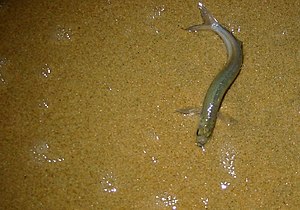Grunion
| Grunion | ||||||||||||
|---|---|---|---|---|---|---|---|---|---|---|---|---|

On the way to the spawning site |
||||||||||||
| Systematics | ||||||||||||
|
||||||||||||
| Scientific name | ||||||||||||
| Leuresthes tenuis | ||||||||||||
| Ayres , 1860 |
The Grunion ( Leuresthes tenuis ) is an atherinopsid (New World earfish) up to 20 cm long , which is known for the fact that its spawning business is coordinated with phases of the moon and takes place “on land”.
description
The Grunion is a silvery, very elongated (thin) fish of the California Pacific coast (it only occurs south of the Monterey Bay). The back and a band along the sides are gray-green or bluish in color. The fish lives in 0 to 18 meters depth always near the coast and near the surface sociable on plankton , possibly small fry.
Fin formula : D1 IV – VII, D2 I / 8–10, AI / 20–24, P 12–15, VI / 5, C 17.
The two dorsal fins are quite far back, the first is small, its rays are thin and flexible. The small pelvic fins are slightly behind the end of the pectoral fins. The anal fin is as long as both dorsal fins including their distance. The caudal fin is bilobed (the lobes are often dark). The almost pencil-like, but flexible fish has 47–50 vertebrae and 6 branchiostegalia. The first gill arch bears 23–29 branchiospins on the inside above , only 5–7 below. The eyes are big. The mouth is small and practically toothless, the upper jaw (the paired premaxillary ) is raised more when the mouth is opened (similar to parrots), but cannot be extended, the lower jaw is shorter. The trunk is covered with small cycloid scales (approx. 60–70 along the lateral lines - of which there are two each: a dorsal and a lateral, but neither of which extends to the caudal fin - probably in connection with the burial activity). The trunk is slightly flattened on the sides, but the head is flattened at the top (depress), forehead (dark) and jaws are therefore quite wide. The skin is slippery (name: Greek leurόs "smooth", esthēs "robe").
behavior
There are few creatures whose rhythm is so clearly linked to the lunar cycle (z. B. Palolowurm , the red mangrove crab ( Pseudosesarma moeshi )). Eggs are laid in the spring and summer (February to August) a few days after a new moon (or full moon) (where, for example flood high up on sandy beaches as well. Horseshoe crabs ( Limulus ) or sea turtles still see the; house their eggs. Capelin ( Mallotus villosus )). The fish meander briefly beyond the reach of the incoming waves and, through violent movements (especially with the tail), cause as many eggs as possible to be buried in the sand (and fertilized by the male embracing the female). This behavior has the advantage that marine predators cannot reach the spawn (but they do, for example, woodlice, crabs, birds, beetles, even ground squirrels) and the sand above the waterline is usually well ventilated. The fry hatch approx. 10-14 days later at the next high tide (hatching is triggered by waves that move the sand, but can also be postponed for two weeks if necessary), are caught by the waves and then live neustically - nectically .
A female can live to be eight years old and spawn up to four times (1600 to over 4000 eggs each) per season. Sexual maturity occurs at a length of approx. 10 cm, i.e. sometimes even in fish of the age 1+. The males are slightly smaller than the females, who can sometimes be surrounded by several milkers when spawning . The spawning game outside the water takes half a minute to several minutes.
The eggs are about 2 mm in size (spherical), without attachments (as is not often the case with Atheriniformes) and contain up to over a hundred yellowish oil balls. They have to be very tolerant of temperature and salinity fluctuations (develop at 10–28 ° C - but not in pure fresh water).
Danger
The grunion is a popular fish whose spawning behavior attracts onlookers every year. Since it is apparently not very common (details are still unclear), it has been protected to a certain extent in California (now also locally in Baja California ) since 1927 - it may e.g. B. can only be caught by hand. However, this does not prevent the Grunion from ending up as by-catch in fishermen's nets. Its spawning beaches are z. Sometimes under protection (which does not keep environmental toxins from agriculture), the spawn may only be dug up for teaching purposes, etc. Commercial catching was never worthwhile because of its low density and size, but the Grunion is considered tasty. Archaeological otolith finds show that grunions were already a popular food among the Indians at spawning time. It goes without saying that they are an important link in the food chain (e.g. as food for seagulls, seals, dolphins and predatory fish).
relative
The very similar species Leuresthes sardina (Jenkins & Evermann, 1889) lives on the east coast of Baja California. It grows up to 25 cm in length and spawns during the day. The separation of the two (now good) species probably took place in the Neogene . Several species of the Atherinopsidae are eidonomically and ecologically quite similar to the Grunion , such as top- and jacksmelt ( Atherinopsis ). Is very similar to the "wrong Grunion" Colpichthys registered Jenkins & Evermann, 1889. The real "smelts" contrast ( smelts though (Osmeridae)) live similar but Stomiati so only very distantly related - they have no prickly (front) Dorsal but one adipose fin ; z. B. Mallotus villosus and Hypomesus .
literature
- California Grunion, Species Profiles: Life Histories and Environmental Requirements of Costal Fishes and Invertebrates (Pacific Southwest). In: Biological Report 82 (11.28) February 1985 PDF
- California's Marine Living Resources: A Status Report. Grunion PDF; 669 kB
Web links
- Grunion on Fishbase.org (English)
- Grunion.org (English)
